In our relentless pursuit to ride the coattails of THE Wayne Wallace, Priti and I made the second ascent of Mongo Ridge (the SW Ridge of West Fury in the Northern Pickets of the North Cascades). It is a Stegasaurus ridge which rises 4,000ft over a mile from Goodell Creek punctuated by thick clusters of gendarmes that look like they’re straight out of the Karakoram.
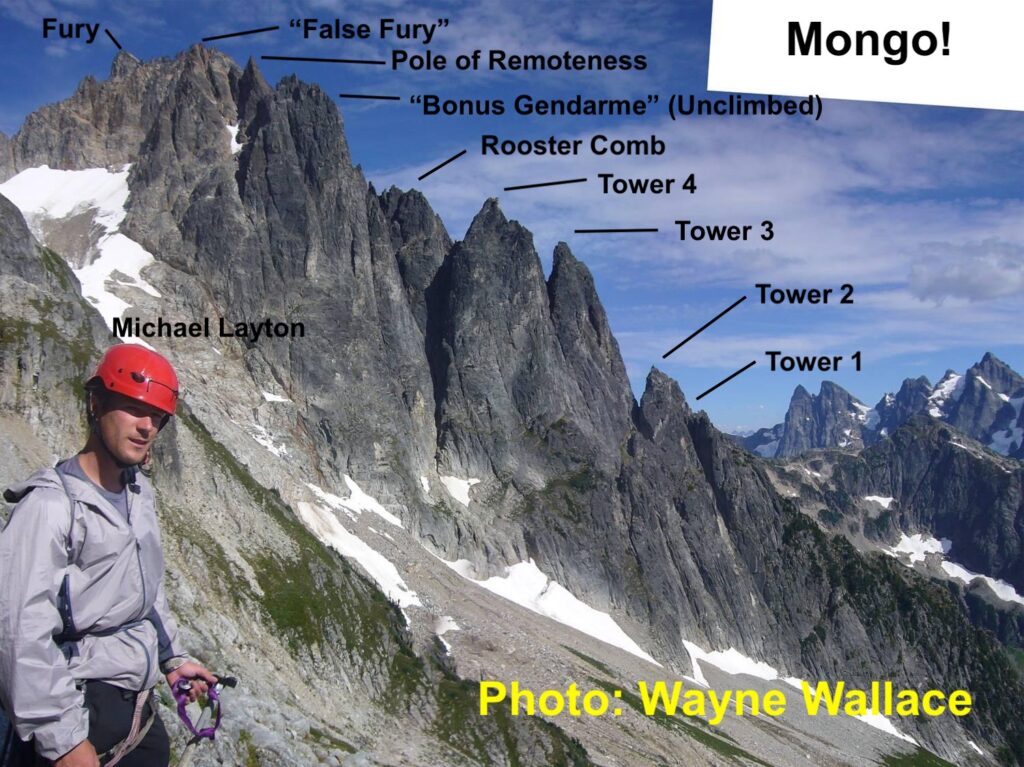
We first heard about Mongo when Wayne came to speak for a BOEALPS Banquet in 2015 and regaled a captive audience with his bold adventures. We warmed up Wayne’s feature presentation with a talk on our trip to Patagonia climbing Aguja de l’S. Then Wayne came on stage talking about Mongo, making de l’S look like a mole-hill.

Wayne climbed this route in 2006 SOLO, like a boss, questing into unknown terrain that easily could have landed him into mandatory hard free climbing. With vertiginous cliffs on both sides, he knew that bailing from the route was not an option and that he had to climb whatever the mountain presented. The difficulties on the route were up to 5.9, with an additional 5.10b pitch (a routefinding error), but the towers presented possibilities up to 5.11 if we weren’t lucky enough to have Wayne’s beta.
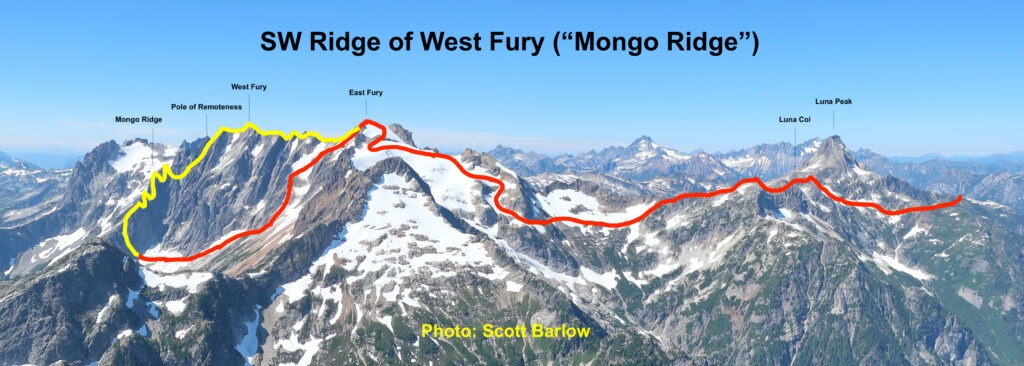
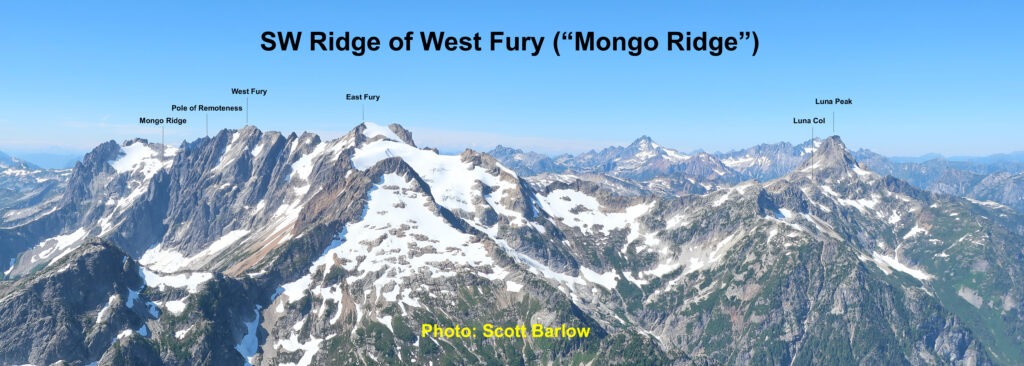
The first ascent is one of the legendary, mythical ascents of the Cascades and even of the climbing world. After 15 years, only a handful of folks to my knowledge have even considered attempting it again.

The bottom half of the ridge has four narrow towers which require you to summit and rappel in order to make vertical progress on the ridge. Long, double-rope rappels and hard technical climbing discouragingly makes it take hours just to ascent 100ft at times. Above these four towers are the “Rooster Comb” and the “Pole of Remoteness” (named by John Roper who figured it was the hardest place to get to in the lower 48).

After Tower 4 and before the Rooster Comb, we scramble traversed low around each of these features and did not summit the Pole of Remoteness since it was getting dark and we did not bring bivy gear. At Wayne’s suggestion (who really overestimated our abilities!), we planned to climb camp-to-camp which was situated at the summit of East Fury.
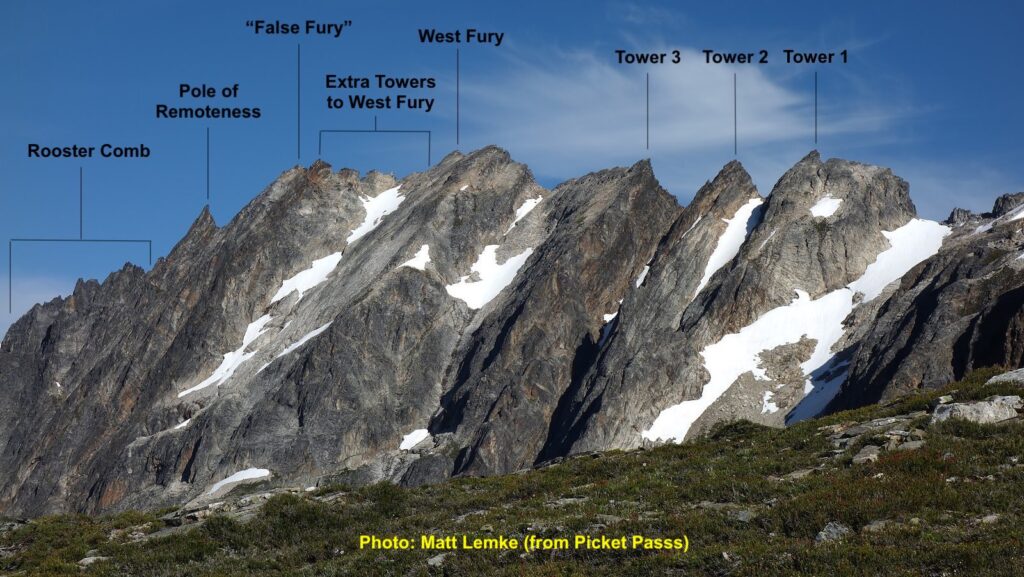
This means that while we did ascend the topographic feature of Mongo Ridge to the summit of West Fury, we did not truly climb “Wayne Wallace’s Mongo Ridge” in the manner that he climbed many more pitches of technical terrain.
When we talked to Wayne in 2019, I told him that “Somebody needs to repeat this route, just so the world can understand what you accomplished.” It’s impossible to understand the scale of this route without being on it, competing as “one of the largest features on any mountain anywhere.” “You have to climb a major mountain [East Fury] just to start a most major climb.”

Even with Wayne’s pictures and descriptions, we were still filled with dread as we attempted to route-find up each tower. While I am proud of what we did accomplish, I am still shaken at the boldness and audacity of the first ascent. Our tale should be considered a celebration of that event.
Wayne called it Alpine Grade VI, but Beckey downgraded it to V deeming it (incorrectly imho) similar in commitment to Slesse NE Buttress (ref. Cascade Alpine Guide Book 3, pg. 118). We concur with Wayne’s Grade VI rating, although I won’t be even slightly offended if anyone wants to challenge the grade while ensconced in sofa cushions.
Our itinerary:
-7/3/21: 2PM boat ride from Ross Lake Resort to Big Beaver TH. Bivy in Access Creek basin.
-7/4/21: Access Creek Basin to East Fury Summit. Left summit bivy in situ.
-7/5/21: 23hr day camp-to-camp including Mongo Ridge and the traverse from West Fury to East Fury.
-7/6/21: East Fury to Access Creek Basin
-7/7/21: Access Creek Basin to Big Beaver TH. 2:30PM boat back to RLR.
Here are collected links regarding Wayne’s FA, for reference:
https://waynewallace.wordpress.com/2014/05/
http://www.alpinist.com/doc/ALP19/climbing-note-fury
http://www.alpenglow.org/nwmj/07/071_Mongo.html
Scurlock Picture: https://www.pbase.com/nolock/image/65948954
I won’t go through too much detail on our approach to Luna Col and East Fury, since it is detailed well in many other places:
http://www.nwhikers.net/forums/viewtopic.php?t=8021967 (specifically useful here is the traverse from East Fury to West Fury)
Since we planned to do the route camp-to-camp (situated on the summit of East Fury), we studied the traverse from West Fury to East Fury in detail since we figured we’d be onsighting it in the dark to get back to camp.

I will point out the “Red Ledge” (pictured above) just past Luna Col is reached by staying directly on the ridgeline from the col to begin the traverse over to East Fury.

Past the Red Ledge, the next tower (called “Crux Tower” in some reports) is ascended directly via 4th class ledges and short 5.4 steps. A rope and gear would not be useful here. There is significant foreshortening here, as the route looks much more accessible as you get closer.

Unless you’re climbing in Winter or Spring, you will not be able to get across the bergshrund (as shown in the Beckey overlay), but instead will traverse left then right to reach the summit arête.

Furthermore, the approach to the base of Mongo Ridge from East Fury’s summit as discovered by Wayne is the easiest approach. While it is possible to reach Mongo’s base via Picket Pass (either by navigating over Outrigger Peak (“Southeast Peak”) or Otto-Himmel Col), these approaches would be significantly more effort.

As you approach, notice the grey washboard streak with an overhanging gully. The route will start to the right of this feature. The 4,000ft descent from East Fury’s summit may involve a lot of slab if the snow levels are low. We regret not bringing bivy gear on route. An alternative itinerary could be:
-Day 1: Big Beaver TH to Luna Col
-Day 2: Luna Col to Mongo Ridge Tower 1. Option to leave stove and tent on East Fury Summit as you pass by. There are no good bivouac sites on route. Just bring a sit pad and a sleeping bag and open bivy if splitter forecast.
-Day 3: Tower 1 to either East Fury or Luna Col.
A note on weather: The Pickets have notoriously unpredictable weather. Even with a splitter forecast, you can still have rain or even storms. Consider a tarp as backup shelter.



Crossing the moat is the first crux. The moat is huge! Only found one place where it touched the rock slightly. On the approach, don’t come down anything you can’t go back up! Here I had to cross a giant moat (unprotectable compact snow), using both Gully tools (then passed the tools down to Priti). A picket here would have been very useful…but that’s a big cost. Might have to bury a tool and rap/swing across the moat.

Tower 1 was a TIME KILLER! Wayne reported a 5.8 overhang crux which we did not find. Instead we got suckered into a runout 5.10b overhang in the grey washboard gully. Recommend future parties to avoid this gully completely, and instead stay on the face to its right.
Our second mistake was getting suckered into a difficult 5.8 grassy gully. Wayne later clarified that he immediately captured the ridge first, then went straight up the ridge (recommended).


We started in an obvious chimney (5.6), gaining the face on the left then going right (many variations).

After the chimney, we went left to the 5.10b overhanging grey gully instead of going up. It looked harder to gain the face above, but it is 5.8 if you can find Wayne’s Way.



The slopes to gain the ridge are all STEEP. We breathed a sigh of relief once we were on situated on the upper slopes of Tower 1, but route finding continued to be a challenge.


A 30m rappel took us down to the notch between Tower 1 and 2. It seems possible to bail here back down the glacier and back up to East Fury. Perhaps the last legitimate bail option, so we considered the time and knew we would be climbing through the night.
Tower 2 is only 2 pitches of 5.7 with no real route finding difficulty and went pretty quickly. The rock is REALLY loose however, so I was careful not to knock anything down on my belayer.

Route lines are all approximate by the way!

The first double rope rappel from Tower 2 led to the notch between Tower 2 and Tower 3.

Tower 3 is the technical crux of the route and another TIME KILLER! It takes hours just to gain 100ft elevation. Once atop, it’s demoralizing to look down and see the top of Tower 2 so close. Wayne reported a 5.10a bulge which I think we avoided by staying on and just right of the ridgeline. From the notch between Towers 2 and 3, a 5.4 traverse gains a grassy belay with 5 more pitches above (30m, 30m, 30m, 50m, 65m). Priti stopped whenever she found a good belay spot. We also hauled packs on 4 pitches expecting 5.10a climbing at any moment. It was real 5.9 climbing, consistently on decent rock for four pitches. Next time, instead of hauling just load everything into the follower pack and leave the leader with a mostly empty backpack instead.
We took two backpacks on this climb to evenly distribute weight and bulk while simul-climbing. This was a good method.

We consistently trended right above the belay.

Higher

Hiiiiiigher

Hiiiiiiiiiigher

Another 60m rappel deposited us to the notch between Towers 3 and 4.

Finally, we got through the technical crux and we were losing sun fast! We knew we were in for an open bivy or a heartbreaking omission of the Pole of Remoteness. Tower 4 is another quick one. Two pitches, 5.9 then 5.7. It looks like really hard climbing going straight up! Instead we followed Wayne’s advice and traversed out right for ~20m on 5.9 terrain with decent protection, then up following flakes and grass to a good belay. As you start climbing up, the climbing doesn’t ease up, but instead is engaging, fun 5.9. Then 65m simul-climb to the summit.



A final 50m rappel down to the base of the Rooster Comb. We were a bit confused here since the terrain opened up into a minefield of gendarmes. The Pole of Remoteness was indistinguishable among all of the towers. We knew we had to boogie so we took all the shortcuts that we could find. We noticed that the Rooster Comb could be bypasses on the right on low-5th terrain by taking another 30m rappel, then down climbing and traversing its Eastern flanks to a grassy gully.

Wayne went up and over the Rooster Comb, not realizing there was a bypass. The Rooster Comb is very complex with several small flagpoles that required rappels. Wayne describes the final rappel off the rooster comb as a “diagonal rappel” that you can redirect off of horns, after which he flaked the rope to retrieve.

There are at least two more intermediate gendarmes between the Rooster Comb and the Pole of Remoteness that we skirted around. Wayne found himself on their left side while we were on their right side. Wayne captured the upper 4th class slopes via a grassy gully (shown above). From here it’s all 4th class to the “False Fury” summit. I coin the label “False Fury” because we stared at this point almost along the entire route thinking it was the West Fury Summit, but instead is fairly far from the true West Fury summit.

Above is pictured our Rooster Comb bypass route which required an additional 30m rappel (or easy down climb). This was the first time we encountered snow on route, but don’t count on it being there! Bring 4L water each.





Southern Pickets in all their glory.


Wayne traversed around the right side of the Pole of Remoteness to reach the col and summit it from the backside. To climb it directly would probably be 5 pitches of hard, loose climbing. From the notch between “False Fury” and the Pole of Remoteness, Wayne reported 1 pitch of 5.7 to reach the summit of the PoR. There is no anchor on top, so he threw a rope around a loose block and solo downclimbed, using the rope as a backup. If you are a team, consider downclimb-belaying. We sadly felt the need to skip the pole since it was total darkness by the time we got to the notch with a lot of traversing left to go.






Once atop “False Fury”, we couldn’t find the summit register and realized that the real West Fury was maybe .25miles away separated by 4 more gendarmes, first downclimbing (or rappelling) down and right and traversing around the first gendarme, then weaving up, over, and around the others to finally reach the real West Fury summit.
Glad to have put in the time to memorize the traverse beta between West and East Fury, it went off slowly but smoothly. One piece of key beta was at the end of Tower 1 (the last tower between the Fury’s), you can find a secret 4th class ramp around to the North (climber’s left) to find the rappel station that leads to the final push up the slopes back to East Fury. This is a 30m rope stretcher rappel, by the way!

Thanks to Wayne for all of your support and encouragement! I think this route is more of a classic in the way that Hummingbird Ridge is a classic. We should really just sit back and marvel at the first ascent. It’s a true Picketeering adventure, but loose rock, lack of bail options, and lack of bivy sites is pretty discouraging. The Pole of Remoteness still needs a second ascent, however! But it would a pretty doable day to get to PoR in-a-day from your East Fury bivouac by traversing high along the ridge and scrambling down from “False Fury”, then reversing the route.
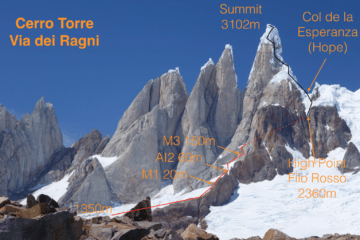
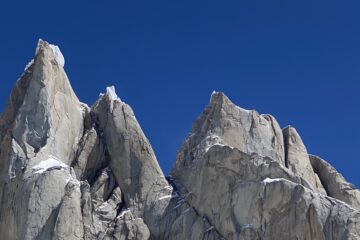
1 Comment
Mongo Ridge, a second ascent – Wayne's site · July 16, 2021 at 7:33 pm
[…] https://alpinevagabonds.com/mount-furys-mongo-ridge-a-second-ascent/It is a unique honor to have close friends that are interested in visiting the path my past exploits. Though we are always trying to hit the bullseye of an almost impossible target, the second dartboard ring is pretty sweet as well! I remember being disappointed that I had to start partway up the ridge, but was not disappointed that I didn’t summit real West Fury. Their disappointment in the rock quality was palpable, as well as not being able to climb in the same way I did. Though I am a serial sandbagger, I don’t remember being too concerned with the quality of rock, it was just a relief to be able to climb up it at all. Time has a way of softening the pain and the memories. I was certainly concerned with the scale of the ridge, so I do feel bad about encouraging them to try to do the whole thing in the day. There was a good reason I took bivy gear, I guess. […]
Comments are closed.